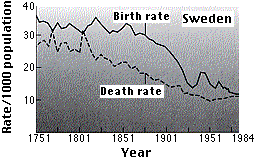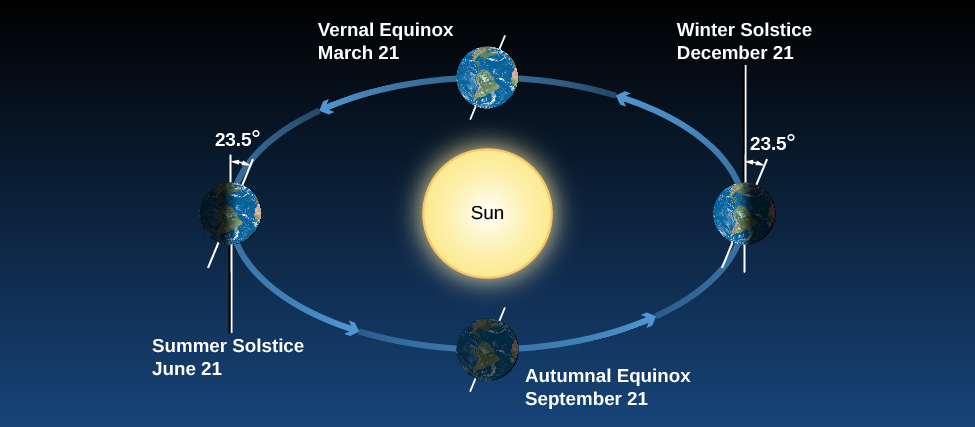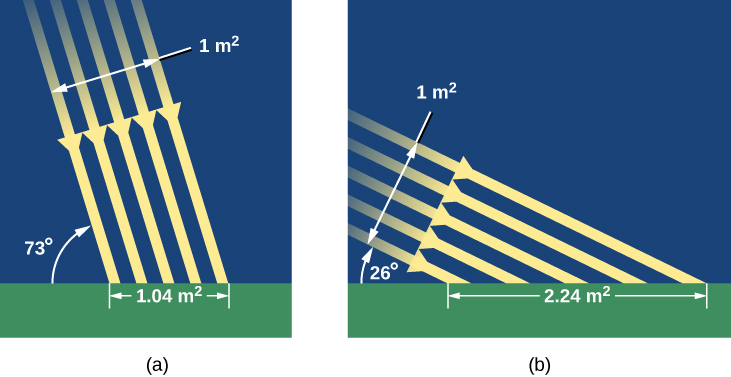Earth’s Temperature is a Balancing Act
Earth’s temperature depends on the balance between energy entering and leaving the planet. When incoming energy from the sun is absorbed, Earth warms. When the sun’s energy is reflected back into space, Earth avoids warming. When energy is released from Earth into space, the planet cools. Many factors, both natural and human, can cause changes in Earth’s energy balance, including:
- Changes in the greenhouse effect, which affects the amount of heat retained by Earth’s atmosphere;
- Variations in the sun’s energy reaching Earth;
- Changes in the reflectivity of Earth’s atmosphere and surface.
The balance of incoming and outgoing heat on Earth is referred to as its energy budget. As with any budget, to maintain constant conditions the budget must be balanced so that the incoming heat equals the outgoing heat. The energy budget of Earth appears below (Figure \(\PageIndex{1}\)).

Figure \(\PageIndex{1}\): Earth’s energy budget. Of all of the solar radiation reaching Earth, 30% is reflected back to space and 70% is absorbed by the Earth (47%) and atmosphere (23%). The heat absorbed by the land and oceans is exchanged with the atmosphere through conduction, radiation, and latent heat (phase change). The heat absorbed by the atmosphere is eventually radiated back into space. Source: Paul Webb, Roger Williams University.
Solar radiation from the sun is composed of mostly ultraviolet (UV), visible light, and infrared (IR) radiation (Figure \(\PageIndex{2}\)). Components of solar radiation include parts with a shorter wavelength than visible light, like ultraviolet light, and parts of the spectrum with longer wavelengths, like IR and others (Figure \(\PageIndex{2}\)). Of all of the solar energy reaching the Earth, about 30% is reflected back into space from the atmosphere, clouds, and surface of the Earth (Figure \(\PageIndex{1}\)). Another 23% of the energy is absorbed by the water vapor, clouds, and dust in the atmosphere, where it is converted into heat.

Figure \(\PageIndex{2}\): Incoming radiation absorbed, scattered, and reflected by atmospheric gases.
Just under half (47%) of the incoming solar radiation is absorbed by the land and ocean, and this energy heats up the Earth’s surface. The energy absorbed by the Earth returns to the atmosphere through three processes; conduction, radiation, and latent heat (phase change) (Figure \(\PageIndex{1}\)).
Conduction is the transfer of heat through direct contact between the surface and the atmosphere. Air is a relatively poor thermal conductor (which means it is a good insulator), so conduction represents only a small part of the energy transfer between the Earth and the atmosphere; equal to about 7% of the incoming solar energy.
All bodies with a temperature above absolute zero (-273o C) radiate heat in the form of longwave, infrared radiation (Figure \(\PageIndex{2}\)). The warmed Earth is no exception, and about 16% of the original solar energy is radiated from the Earth to the atmosphere (Figure \(\PageIndex{1}\)). When sunlight warms a surface such as a paved surface, a patio, or deck, the warmer surface emits more thermal radiation, which is a type of IR radiation. So, there is a conversion from visible, UV, and IR to just thermal IR. This thermal IR is what we experience as heat. Some of this radiated energy will dissipate into space, but a significant amount of heat will be absorbed by the atmosphere. This is the basis for the greenhouse effect (Figure \(\PageIndex{3}\)). In the greenhouse effect, shortwave solar radiation passes through the atmosphere and reaches the Earth’s surface where it gets absorbed. When the radiation is re-emitted by the Earth, it is now in the form of long wavelength, infrared radiation, which does not easily pass through the atmosphere. Instead, this infrared radiation is absorbed by the atmosphere, particularly by the greenhouse gases such as CO2, methane, and water vapor. As a result, the atmosphere heats up. Some of the infrared radiation absorbed by the atmosphere is also re-emitted back to the planet's surface, further increasing warming. Without the greenhouse effect, the average temperature on Earth would be about -18o C, which is too cold for liquid water, and therefore life as we know it could not exist!

Figure \(\PageIndex{3}\): An explanation of the greenhouse effect. "Earth's Greenhouse Effect" by US EPA is available in the public domain.
The largest pathway for energy exchange between the land or oceans and the atmosphere is latent heat transferred through phase changes; heat released or absorbed when water moves between solid, liquid, and vapor forms. Heat must be added to liquid water to make it evaporate, and when water vapor is formed, that heat is removed from the ocean and transferred to the atmosphere along with the water vapor. When water vapor condenses into rain, that heat is then returned to the oceans. The same process happens with the formation and melting of ice. Heat is absorbed by ice when it melts, and heat is released when ice forms, and these phase changes transfer heat between the oceans and the atmosphere.
To complete the energy budget, the heat that is absorbed by the atmosphere either directly from solar radiation or as a result of conduction, radiation and latent heat, is eventually radiated back into space (Figure \(\PageIndex{1}\)).
Greenhouse Gasses
Throughout this chapter we will be talking about the role of greenhouse gases (GHGs) in controlling the climate, so it is important to understand what greenhouse gases are and how they work. As you know, the dominant gases of the atmosphere are nitrogen (as N2) and oxygen (as O2). These gas molecules have only two atoms each and are not GHGs. Some of the other important gases of the atmosphere are water vapor (H2O), carbon dioxide (CO2), and methane (CH4). All of these have more than two atoms, and they are GHGs. (For more information on the relative amounts of different gasses in the atmosphere, see Atmosphere). All molecules vibrate at various frequencies and in various ways, and some of those vibrations take place at frequencies within the range of the infrared (IR) radiation that is emitted by Earth’s surface. Gases with two atoms, such as O2, can only vibrate by stretching (back and forth), and those vibrations are much faster than the IR radiation (Figure \(\PageIndex{4}\)). Gases with three or more atoms (such as CO2) vibrate by stretching as well, but they can also vibrate in other ways, such as by bending (Figure \(\PageIndex{4}\)). Those vibrations are slower and match IR radiation frequencies. When IR radiation interacts with CO2 or with one of the other GHGs, the molecular vibrations are enhanced because there is a match between the wavelength of the IR light and the vibrational frequency of the molecule. This makes the molecule vibrate more vigorously, heating the surrounding air in the process. These molecules also emit IR radiation in all directions, some of which reaches Earth’s surface. The heating caused by the more vigorous vibrations of GHGs is the greenhouse effect.

Figure \(\PageIndex{4}\): Stretching versus bending vibrations in atmospheric gases. Image by Steven Earle is licensed under CC BY.
Differential Heating of Earth’s Surface
If the Earth was a flat surface facing the sun, every part of that surface would receive the same amount of incoming solar radiation. However, because the Earth is a sphere, sunlight is not equally distributed over the Earth’s surface, so different regions of Earth will be heated to different degrees. This differential heating of Earth’s surface occurs for a number of reasons. First, because of the curvature of Earth, sunlight only falls perpendicularly to the surface at the center of the sphere (equatorial regions). At any other point on Earth, the angle between the surface and the incoming solar radiation is less than 90o. Because of this, the same amount of incoming solar radiation will be concentrated in a smaller area at the equator, but will be spread over a much larger area at the poles (Figure \(\PageIndex{5}\)). Thus the tropics receive more intense sunlight and a greater amount of heating per unit of area than the polar regions. The angle at which sunlight strikes the Earth contributes to differential heating of the surface in an additional way. At the poles, because of the angle at which the solar energy strikes the surface, more of the light will glance off of the surface and the atmosphere and be reflected back into space. At the equator, the direct angle with which light reaches the surface results in more of the energy being absorbed by the earth rather than being reflected (bouncing off the surface). Recall that the earth is also tilted, changing which part of the earth's surface is pointed directly at the sun during different seasons (see What Makes the Climate Change for more on Earth's Tilt).

Figure \(\PageIndex{5}\): Because of the curvature of the Earth, the same amount of sunlight will be spread out over a larger area at the poles compared to the equator. The equator therefore receives more intense sunlight, and a greater amount of heat per unit of area. "Solar Angle of Incidence on Earth" by Thebiologyprimer is available in the public domain.
Finally, the poles reflect more solar energy than other parts of the Earth because the poles have a higher albedo. The albedo refers to reflectivity of a surface, expressed as the percentage of light that reflects off a given material. Lighter surfaces are more reflective than darker surfaces (which absorb more energy), and therefore have a higher albedo. Water in the oceans or on a lake is one of the darkest surfaces, reflecting less than 10% of the incident light, while clouds and snow or ice are among the brightest surfaces, reflecting 70% to 90% of the incident light (Figure \(\PageIndex{6}\)).

Figure \(\PageIndex{6}\): Typical albedo values for Earth surfaces. Image by Steven Earle is licensed under CC BY.
At the poles, the ice, snow and cloud cover create a much higher albedo, and the poles reflect more and absorb less solar energy than the lower latitudes (Figure \(\PageIndex{7}\)). Through all of these mechanisms, the poles absorb much less solar radiation than equatorial regions, which is why the poles are cold and the tropics are very warm.

Figure \(\PageIndex{7}\): Surface of Earth with Cloud Cover Removed -- The surface of the Earth with cloud cover removed. The poles and deserts are much brighter than the oceans and forests. Source: NASA Goddard Space Flight Center Image by Reto Stöckli. Courtesy of NASA's Earth Observatory.
But there is an interesting twist to this global distribution of heat. The tropical regions actually receive more radiant heat than they emit, and the poles emit more heat than they receive (Figure \(\PageIndex{8}\)). We should therefore expect that the tropics will be getting continually warmer, while the poles become increasingly cold. Yet this is not the case; so what is happening? Rather than the heat remaining isolated near the equator, about 20% of the heat from the tropics is transported to the poles before it is emitted. This large scale transport of energy moderates the climates at both extremes. The mechanisms for this heat transfer are ocean and atmospheric circulation.

Figure \(\PageIndex{8}\): The balance between heat gain and heat loss as a function of latitude. Excess heat received near the equator is transferred towards the poles Source: National Oceanography Centre (NOC).
The Earth's Tilt causes Seasons
One of the fundamental facts of life at Earth’s mid-latitudes, is that there are significant variations in the heat we receive from the Sun during the course of the year. The difference between seasons gets more pronounced the farther north or south from the equator we travel, and the seasons in the Southern Hemisphere are the opposite of what we find on the northern half of Earth. The seasons are actually caused by the 23.5° tilt of Earth’s axis which continues to point the same direction in the sky throughout the year (figure \(\PageIndex{9}\)). As Earth travels around the Sun, in June the Northern Hemisphere “leans into” the Sun and is more directly illuminated. In December, the situation is reversed: the Southern Hemisphere leans into the Sun, and the Northern Hemisphere leans away. In September and March, Earth leans “sideways”—neither into the Sun nor away from it—so the two hemispheres are equally favored with sunshine. When we lean into the Sun, sunlight hits us at a more direct angle and is more effective at heating Earth’s surface (figure \(\PageIndex{10}\)). During the summer season, the sun also spends more time above the horizon, resulting in more energy hitting the surface of the Earth.

Figure \(\PageIndex{9}\): We see Earth at different seasons as it circles the Sun. In June, the Northern Hemisphere “leans into” the Sun, and those in the North experience summer and have longer days. In December, during winter in the Northern Hemisphere, the Southern Hemisphere “leans into” the Sun and is illuminated more directly. In spring and autumn, the two hemispheres receive more equal shares of sunlight. Source: 4.2: The Seasons.

Figure \(\PageIndex{10}\): The Sun's Rays in Summer and Winter. (a) In summer, the Sun appears high in the sky and its rays hit Earth more directly, spreading out less. (b) In winter, the Sun is low in the sky and its rays spread out over a much wider area, becoming less effective at heating the ground. Source: 4.2: The Seasons.












